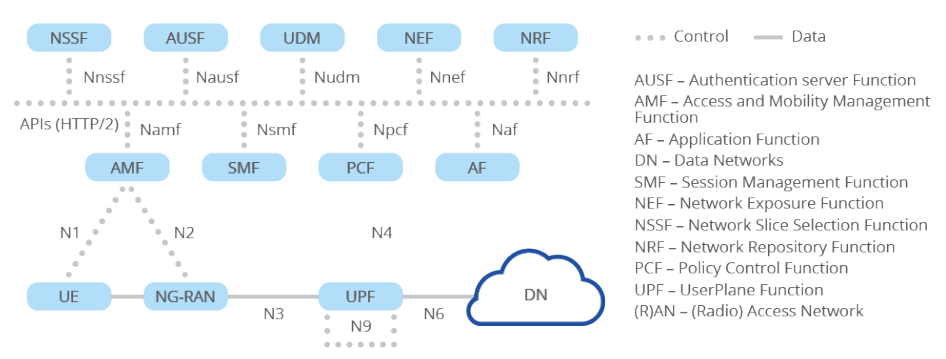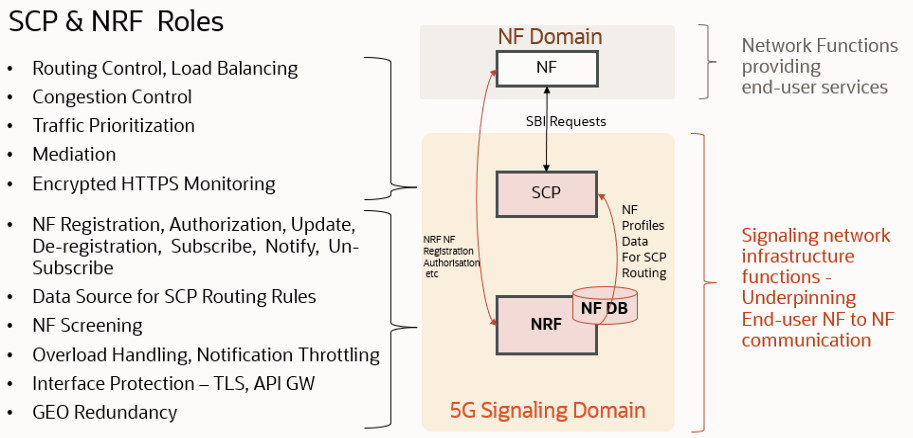5G standalone (SA) operation, using a new core network, is foundational to mobile operators seeking to offer advanced 5G services with a low cost of production.
5G Service-based architecture (SBA)
In a SBA framework, the individual elements are defined as Network Functions (NFs) instead of Network entities. Through Service Based Interface (SBI) each of the NFs consumes services offered by other service producers and other NFs. RESTful APIs are used in 5G SBA which use HTTP/2 as application layer protocol.
The overall 5G system architecture can be broadly separated into the RAN and the core, further divided into the user and control planes. The large majority of functions are in the control plane.
The 5G core uses the 3GPP SBA, which adopts service-orientated software design principles, to enable NFs to connect across a service mesh using APIs. This is a major change from the point-to-point architecture used in the 4G core and gives operators greater operational flexibility to add, remove, or upgrade functions without impacting live service or requiring wholesale changes to the deployed architecture.

Another important difference is that the 5G core incorporates more functional entities in the architecture. In a 4G evolved packet core (EPC), around 10 discrete node types are typically deployed; in a 5G core, the number of discrete NFs increases to more than 20. The SBA makes it easier to support this wide range of functions and for operators to evolve to more sophisticated 5G core networks as they add capabilities and extend their service offer.
What is a Network Repository Function (NRF)?
The NRF is one of the main key components of the 5G Service-Based Architecture. The NRF maintains an updated repository of all the 5G elements available in the operator’s network along with the services provided by each of the elements in the 5G core that are expected to be instantiated, scaled, and terminated without or minimal manual intervention.
The NRF supports discovery mechanisms that allow 5G elements to discover each other and get updated status of the desired elements. The NRF supports the following functions:
- Maintains the profiles of the available NF instances and their supported services in the 5G core network.
- Allows consumer NF instances to discover other providers of NF instances in the 5G core network.
- Allows NF instances to track the status of other NF instances.
What If There’s No NRF in the 5G Network?
If there is no NRF in the network, there is no mechanism for dynamic updates to the network changes. Operators need to monitor all NFs in the network and accordingly re-configure NFs to align with these changes. Node selection is based on multiple search parameters and is mostly static without NRF. There is also no mechanism for health check of NFs when there is no NRF in the network.
When there is NRF in the network, dynamic updates are automated. 5GC NFs subscribe with NRF to get notified of network events. NRF also acts as an authorization server in the network which would authorize consumer NFs to proceed with service requests to the producer NFs. The NFs that are registered with the NRF send a heartbeat periodically, when there is a heartbeat lost, the NRF marks the NF as suspended and notifies this change to all subscribed IFs. Suspended NRF is not included as prospective producer NRF in discovery responses till heartbeat starts again. In addition to identifying failure, NRF provides the alternate producer.
What is a Service Communication Proxy (SCP)?
The Service Communication Proxy (SCP) includes one or more of the following functionalities. Some or all of the SCP functionalities may be supported in a single instance of an SCP:
- Indirect Communication.
- Delegated Discovery.
- Message forwarding and routing to destination NF/NF service.
- Message forwarding and routing to a next hop SCP.
- Communication security (e.g. authorization of the NF Service Consumer to access the NF Service Producer API), load balancing, monitoring, overload control, etc.
SCPs can be deployed at the PLMN level, shared-slice level, and slice-specific level. It is left to operator deployment to ensure that SCPs can communicate with relevant NRFs. To enable SCPs to route messages through several SCPs (i.e. next SCP hop discovery), an SCP may register its profile in the NRF. Alternatively, local configuration may be used.
3GPP Release 16 introduced indirect communication between service consumer and producer via SCP, which offloads network functions from performing the following responsibilities:
- Delegated discovery and selection
- Load balancing & alternate routing
- 5G SBI traffic feed
- Rate limiting and producer congestion control
5G Core Models
3GPP Release 16 introduced indirect communication with new modes of communication to SBAs. In contrast to the modes of communication specified in Release 15, where the service consumer and producer interact directly, the new modes of communication are indirect via a Service Communication Proxy (SCP) that mediates messages between the service consumer and producer.

- Model A: Consumer and producer NFs can “talk” directly to one another. This direct connection model is Model A. This works for smaller-scale deployments with lower numbers of users and transactions. However, it limits operational flexibility and has scaling challenges.
- Model B: consumer NFs, instead of communicating directly with a producer NF to request service, first query the NRF to ask which producer to use before making a direct connection with the producer. The NRF, in this model, can select the appropriate producer NF and provide services such as load balancing.
- Models C and D: an SCP is introduced as a proxy between consumers and producers. In Model D, for instance, consumer NFs simply send requests to the SCP, which then identifies the appropriate producer NFs (via the NRF) and returns the requested information. The appeal of this model is that it simplifies the NF, making it easier to add/swap/change NFs and to scale the 5G core as service requests increase. In effect, the SCP deployment becomes a 5G core service mesh.
The use of an SCP in 5G core networks is comparable to the use of a diameter routing agent in 4G mobile core networks and shares some similar benefits.
The main difference between Model C and Model D is that in Model C, the Consumer NF (cNF) is responsible for discovering a Producer NF (pNF) using the NRF (e.g., through SCP), and then initiates communication through the SCP. In contrast, in model D, the discovery is delegated entirely to the SCP.

What is the Relation between NRF and SCP?
NRF being part of the Signaling Domain, also acts as a data source for Service Communication Proxy (SCP), which builds routing rules based on NRF-supplied NF status. It is a prerequisite for SCP, a key 5G Service Requests routing component that requires a real-time network-wide view of the Network Functions and services.

